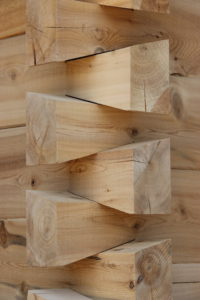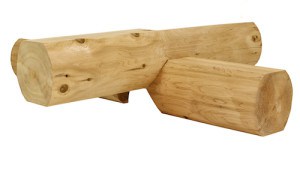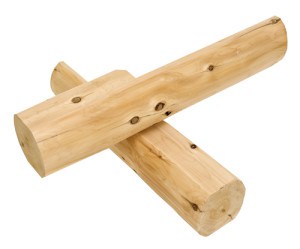Finishing Touches: Log Corners Create That Real Log Home Look
 When you’re building a conventional frame home but giving it a log home look, log siding is the obvious building material ― but don’t overlook the details. Choosing the right log corner is an important design element to achieve that real log home look for your clients. Log corners add an essential finishing touch and, they can also impact the sturdiness and longevity of the home.
When you’re building a conventional frame home but giving it a log home look, log siding is the obvious building material ― but don’t overlook the details. Choosing the right log corner is an important design element to achieve that real log home look for your clients. Log corners add an essential finishing touch and, they can also impact the sturdiness and longevity of the home.
Corner systems, sometimes referred to as notches, are how two perpendicular logs are joined together. When selecting a corner type for your project, there are many factors to consider including cost, required skill level, installation time, as well as design. The most common types of corner systems are dovetail, butt and pass, corner post, and saddle notches. Below we’ve outlined the main features of each.
 Dovetail
Dovetail
The dovetail notch is well-suited for many log home styles and is one of the oldest log home corner types. Logs are cut with trapezoidal notches that resemble the shape of a dove’s tail. When the logs are stacked, the dovetail notches securely interlock together and create a strong joint.
Aesthetics: Dovetail corners give an authentic stacked heritage log home appearance.
Durability and Strength: Few corner systems are as strong and durable as the dovetail. This notch type has superior tensile strength, which means it is highly resistant to separation.
The dovetail corner system is a favorite among many builders because of its waterproofing characteristics. Water is naturally directed away from the home because of the way the dovetail notches are slanted. Other systems may trap water, which can lead to rot. This system also minimizes log-to-log contact, which can further reduce rot.
Heartwood Mills Products: You can easily create the heritage look with our dovetail notches. We offer smooth or rough sawn dovetails, and Adzed is available upon request.
Saddle Notches
Traditional saddle notches are one of the most recognizable corner systems (think Lincoln Logs, the popular wooden building toy). Saddle notch corner systems use a series of notches that may differ in sizes and shapes. The logs are stacked on top of each other, and the notches help the logs fit perfectly together.

The compression fit saddle notch is a very popular type of corner system. Sometimes referred to as the Scandinavian saddle notch, this corner uses an early technique where the logs fit more tightly together over time, as the logs shrink and settle.
Aesthetics: Many consider the beauty and elegance of saddle notch corners as a quintessential element of a traditional log home. If you want an old-world style with minimal maintenance, this is the choice for you.
Durability and Strength: Although the traditional saddle notch requires skilled craftsmanship to assemble, the benefits are very similar to the dovetail notch. Saddle notch systems create durable, airtight seals and unmatched durability. This corner system creates a very strong home and is highly weather resistant. And, if the logs are installed correctly, no chinking or additional insulation is needed – which greatly reduces maintenance needs over time.
Heartwood Mills Products: Our saddle notch corners can help you achieve an authentic stacked log home appearance. We hand-scribe our saddle notch corners to provide a perfect fit while maintaining uniqueness.
 Corner Posts
Corner Posts
Corner posts provide a contemporary, clean, and distinctive look. Rather than using notches to join perpendicular logs to each other, logs are joined to a vertical corner post.
Aesthetics: Because most log home corner systems utilize intersecting joints between logs, the corner post system really stands out as a unique and recognizable design. This corner type provides a modern, clean, boxy design that many people find very appealing.
Durability and Strength: Because all of the joints are concealed within the vertical post, corner post systems are highly durable and resistant to weather elements. This method also creates tight joints and allows the logs to expand and contract naturally.
Heartwood Mills Products: With our Vertical Hand Hewn Log Cabin Corners, it’s easy to achieve the unique look and feel of a Corner Post system. We have both interior and exterior applications available.
Butt and Pass Corners

In the 1950s, Skip Ellsworth created the butt and pass notch as a way to provide a quick and easy method to enable even novice craftsmen to build a log home. The secret to this corner style is that is doesn’t actually use a notch! Rather, logs are stacked on top of each other and rebar is used to join them together.
Aesthetics: Aesthetically, butt and pass corners look like traditional Scandinavian saddle notches, but they have the benefit of reduced cost and installation time.
Durability and Strength: The main benefit of this system is reduced building time and cost because intricate notching isn’t required. Butt and pass corners may also have reduced settling over time, which makes framing around doors and windows easier.
Heartwood Mills Products: Heartwood Mills butt and pass corner systems give the look of full logs extending from the home and are available in Northern White Cedar and Pine.
Choosing the right corner will add aesthetic appeal and complete that traditional log home look your customers desire. Corners can also improve the longevity and weather resistance of homes. There are many options to choose from and factors to consider. Have more questions about log corners? We are happy to help! Contact our experts and let us help you select the best corner for your next log home project.
